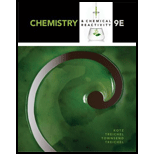
Concept explainers
(a)
Interpretation:
The primary species present in an aqueous solution of given compound has to be identified and the species either Bronsted acid or Bronsted base and strong or weak should be identified.
Concept introduction:
Most of the ionic compounds are soluble in water, very few of the ionic compounds are sparingly soluble, and some of the ionic compounds are insoluble in water. When it is soluble in water ions gets separated in the solution.
Bronsted acid: An acid donates (loses)
Bronsted Base: A base accepts (gains)
Acids are two types one is strong another one is weak similarly, two types of base one is strong and another one is weak. Acid strength can be measured by using acid-dissociation equilibrium constant,
If
If
(b)
Interpretation:
The primary species present in an aqueous solution of given compound has to be identified and the species either Bronsted acid or Bronsted base and strong or weak should be identified.
Concept introduction:
Most of the ionic compounds are soluble in water, very few of the ionic compounds are sparingly soluble, and some of the ionic compounds are insoluble in water. When it is soluble in water ions gets separated in the solution.
Bronsted acid: An acid donates (loses)
Bronsted Base: A base accepts (gains)
Acids are two types one is strong another one is weak similarly, two types of base one is strong and another one is weak. Acid strength can be measured by using acid-dissociation equilibrium constant,
If
If
(c)
Interpretation:
The primary species present in an aqueous solution of given compound has to be identified and the species either Bronsted acid or Bronsted base and strong or weak should be identified.
Concept introduction:
Most of the ionic compounds are soluble in water, very few of the ionic compounds are sparingly soluble, and some of the ionic compounds are insoluble in water. When it is soluble in water ions gets separated in the solution.
Bronsted acid: An acid donates (loses)
Bronsted Base: A base accepts (gains)
Acids are two types one is strong another one is weak similarly, two types of base one is strong and another one is weak. Acid strength can be measured by using acid-dissociation equilibrium constant,
If
If
(d)
Interpretation:
The primary species present in an aqueous solution of given compound has to be identified and the species either Bronsted acid or Bronsted base and strong or weak should be identified.
Concept introduction:
Most of the ionic compounds are soluble in water, very few of the ionic compounds are sparingly soluble, and some of the ionic compounds are insoluble in water. When it is soluble in water ions gets separated in the solution.
Bronsted acid: An acid donates (loses)
Bronsted Base: A base accepts (gains)
Acids are two types one is strong another one is weak similarly, two types of base one is strong and another one is weak. Acid strength can be measured by using acid-dissociation equilibrium constant,
If
If
Want to see the full answer?
Check out a sample textbook solution
Chapter 3 Solutions
Chemistry & Chemical Reactivity
- Follow the directions of Question 19 for the following acids: (a) hypochlorous acid (b) formic acid, HCHO2 (c) acetic acid, HC2H3O2 (d) hydrobromic acid (e) sulfurous acidarrow_forwardThe formula for tartaric acid is preferably written as H2C4H4O6 rather than as C4H6O6. Explain why.arrow_forwardA solution of sodium cyanide, NaCN, has a pH of 12.10. How many grams of NaCN are in 425 mL of a solution with the same pH?arrow_forward
- Use the appropriate tables to calculate H for (a) the reaction between MgC03(s) and a strong acid to give Mg2+(aq), CO2(g), and water. (b) the precipitation of iron(III) hydroxide from the reaction between iron(III) and hydroxide ions.arrow_forwardWhat is the molar concentration of all the ions in a solution of 0.120M Al2(SO4)3?arrow_forwardCaCl2 is a… (acid, base, or what?)arrow_forward
- Write an equation to show that hydrochloric acid , HCl , behaves as an acid in water. Write an equation to show that hypochlorous acid , HClO , behaves as an acid in water. Write a net ionic equation to show that phosphoric acid, H3PO4, behaves as an acid in water. Consider only its first ionization.arrow_forwardWhat is the pH of a 5.95 M solution of HNO3(aq)?arrow_forwardWhich of the substances have a strong base?arrow_forward
 Chemistry: Principles and ReactionsChemistryISBN:9781305079373Author:William L. Masterton, Cecile N. HurleyPublisher:Cengage Learning
Chemistry: Principles and ReactionsChemistryISBN:9781305079373Author:William L. Masterton, Cecile N. HurleyPublisher:Cengage Learning Chemistry for Engineering StudentsChemistryISBN:9781337398909Author:Lawrence S. Brown, Tom HolmePublisher:Cengage Learning
Chemistry for Engineering StudentsChemistryISBN:9781337398909Author:Lawrence S. Brown, Tom HolmePublisher:Cengage Learning Chemistry & Chemical ReactivityChemistryISBN:9781133949640Author:John C. Kotz, Paul M. Treichel, John Townsend, David TreichelPublisher:Cengage Learning
Chemistry & Chemical ReactivityChemistryISBN:9781133949640Author:John C. Kotz, Paul M. Treichel, John Townsend, David TreichelPublisher:Cengage Learning Chemistry & Chemical ReactivityChemistryISBN:9781337399074Author:John C. Kotz, Paul M. Treichel, John Townsend, David TreichelPublisher:Cengage Learning
Chemistry & Chemical ReactivityChemistryISBN:9781337399074Author:John C. Kotz, Paul M. Treichel, John Townsend, David TreichelPublisher:Cengage Learning Principles of Modern ChemistryChemistryISBN:9781305079113Author:David W. Oxtoby, H. Pat Gillis, Laurie J. ButlerPublisher:Cengage Learning
Principles of Modern ChemistryChemistryISBN:9781305079113Author:David W. Oxtoby, H. Pat Gillis, Laurie J. ButlerPublisher:Cengage Learning Chemistry: The Molecular ScienceChemistryISBN:9781285199047Author:John W. Moore, Conrad L. StanitskiPublisher:Cengage Learning
Chemistry: The Molecular ScienceChemistryISBN:9781285199047Author:John W. Moore, Conrad L. StanitskiPublisher:Cengage Learning





